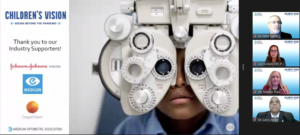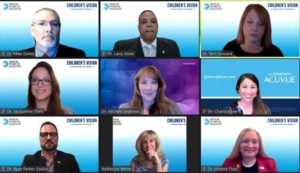March 25, 2021
ST. LOUIS — On March 24th, the American Optometric Association (AOA) hosted a summit on the state of children’s eye health and what ECPs can do to help their young patients. The virtual event was sponsored by Johnson & Johnson Vision, CooperVision, and Essilor, and featured insights from several leaders in the eye care field.
The session was geared toward highlighting how the COVID-19 pandemic has increased digital eye strain among the youngest population, in addition to exploring how the ever-increasing number of childhood myopia cases continues to be a cause for concern among ECPs. The panelists also discussed how the two are related and why excessive time indoors and in front of screens in the last year can greatly impact the myopia epidemic. A few panelists discussed how the pandemic has led myopia progression to surge in many children.
“I’m very concerned about what’s going to happen with myopia. We know myopia has a genetic basis but also an environmental basis as well. We’re starting to see some early indications that myopia is progressing faster coming out of the pandemic because of all the time in that environment — up close, kind of locked in,” said Ryan Parker, OD, director of Professional Development at Essilor. “As eye care professionals, it’s our job to educate our patients, because we need to get them outside, but don’t forget there’s risk outside as well. So we need to talk about great protection, both indoors and outdoors.”
 “When we think about children in particular, one of the primary concerns to emerge from the pandemic is the potential for the increased progression of myopia during these critical developmental years. That progression is being influenced by increased screen time and near demands, and it is coupled with reduced outdoor time, social distancing, and self-isolation,” said Michele Andrews, OD, VP of Professional and Government Affairs at CooperVision. “What we know about the influence of lifestyle factors on myopia progression, the new norms of pandemic life may be exacerbating this situation for our kids.”
“When we think about children in particular, one of the primary concerns to emerge from the pandemic is the potential for the increased progression of myopia during these critical developmental years. That progression is being influenced by increased screen time and near demands, and it is coupled with reduced outdoor time, social distancing, and self-isolation,” said Michele Andrews, OD, VP of Professional and Government Affairs at CooperVision. “What we know about the influence of lifestyle factors on myopia progression, the new norms of pandemic life may be exacerbating this situation for our kids.”
Though the myopia pandemic requires serious attention, Dr. Andrews explained that this time can be beneficial for ECPs in reaching out to parents and caregivers and spreading awareness about the risks to their children’s eye health.
“Now that parents and children are together more at home, and parents are seeing how their children are using their visual systems throughout the day, our opportunity to reach out and connect with parents on this topic may be greater now than it’s ever been,” Dr. Andrews said. In addition to education, we can use these moments to create a call to action, and get these kids in for comprehensive exams. Specifically with myopia, we know that once it progresses, there’s no going back. It changes a child’s quality of life and exposes them to ocular health risks for the rest of their lives.”
The panelists agreed that comprehensive eye exams are key in combatting the myopia epidemic, and it’s important for ECPs to make that clear to their patients and their communities.
“This is a moment for optometry. As an industry, we can and must lead in educating our communities on the risks of not only myopia progression, but the importance of comprehensive eye exams,” Dr. Andrews said. “We’re not going to be able to do it alone. We need to work closely with everyone in the life of a child to address the myopia epidemic as effectively as possible.”
“We need to come together as a profession and get that message out there — the importance of early and often comprehensive eye exams,” said Dr. Parker. “The Global Myopia Awareness Coalition (GMAC) is working on this for myopia, so I think we can take some of their learnings and maybe even make it a broader message.”














